Coronavirus Today: China rewrites the history of COVID-19
Good evening. I’m Karen Kaplan, and it’s Friday, June 25. Here’s what’s happening with the coronavirus in California and beyond.
Chen Mei and Cai Wei are friends and computer coders who live in China. In the early months of the pandemic, they decided to put their skills to use by creating an online archive about the COVID-19 outbreak, the whistleblowing doctors who tried to warn the world of the growing threat and the unprecedented lockdown of Wuhan.
Their archive, called Terminus2049, included reports by Chinese journalists who risked their lives to cover the story of the mysterious and deadly respiratory disease. The reward for their courage was censorship, as Chinese President Xi Jinping pushed for propaganda that extolled heroes, not stories that shed light on human suffering.
Chen, 28, and Cai, 27, may have had an inkling that the government wouldn’t appreciate their project. But they didn’t expect to be detained for documenting an event that was hardly a secret, said Chen Kun, Chen Mei’s older brother.
“Ten years ago, this wouldn’t be a problem. You wouldn’t be detained for just archiving information. At most, they’d threaten you and ‘have tea,’” Chen Kun told my colleague Alice Su, using a euphemism for disciplinary meetings with authorities. “We didn’t realize that in 2019 and 2020, China’s internet control became much stricter than in the past.”
Chen and Cai were held in detention for more than a year, until they went on trial last month in Beijing. The friends were accused of “picking quarrels and provoking troubles,” the same crime used to silence Chinese citizens who try to bring attention to the 1989 massacre of hundreds of pro-democracy protesters in Tiananmen Square.
Family members were not allowed to see Chen and Cai. They couldn’t hire lawyers to defend them or examine the documents explaining the charges against them, Chen Kun said. A verdict is expected in July or August; if they’re found guilty, they’ll face up to five years in prison.
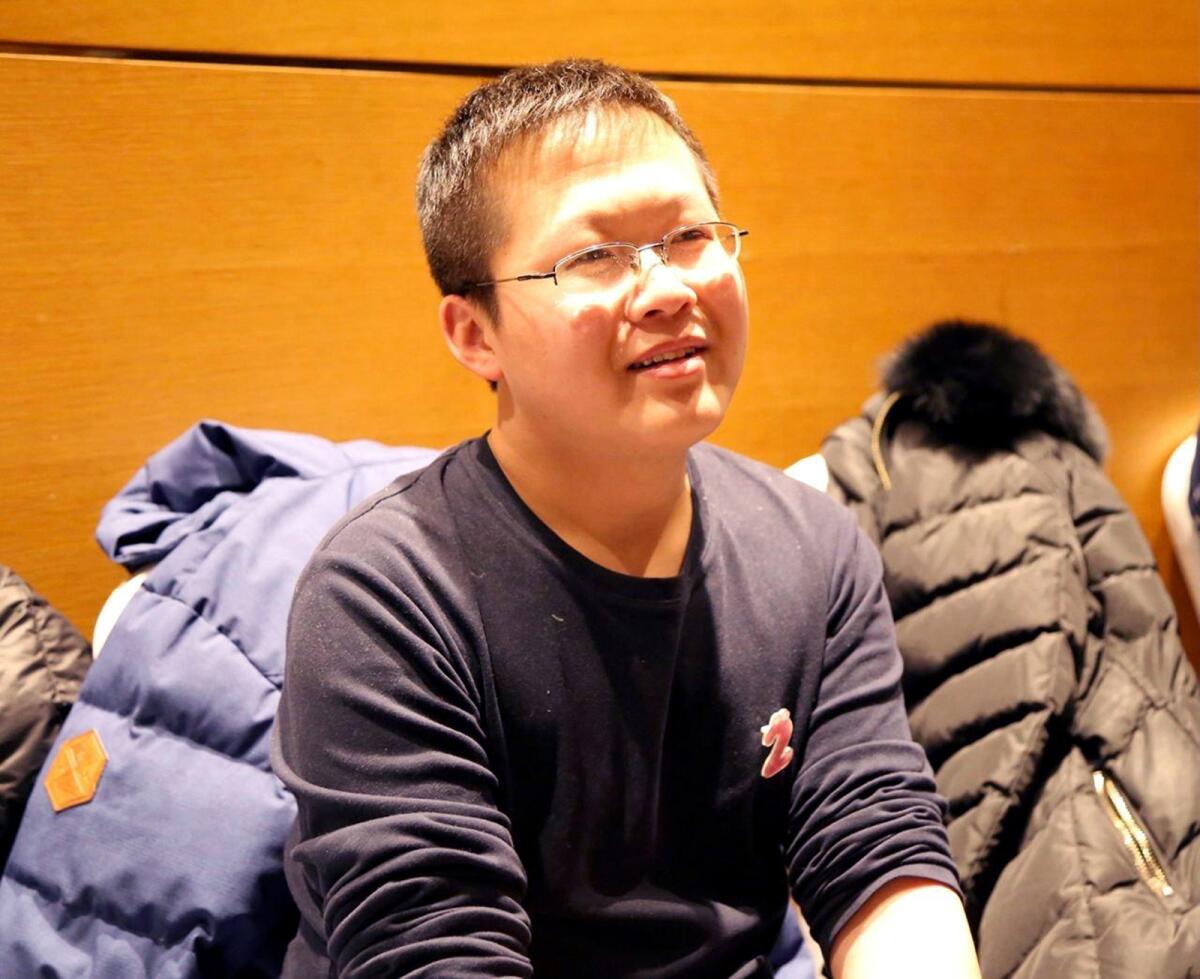
And this is just one of more than 600 cases of people being punished for speaking up about COVID-19 and the Chinese government’s pandemic response.
There’s a man from Qinghai who got 10 months in jail for criticizing on Twitter the government’s handling of the outbreak. There’s a Beijing resident who was held for six months for warning classmates in WeChat about a person who had contracted COVID-19. There’s a blogger in Hebei province who was sentenced to half a year in prison for compiling stories of Wuhan residents’ suffering during the lockdown.
This hostility toward free speech comes as China’s Communist Party prepares to celebrate its centennial. For the occasion, Xi launched a nationwide campaign for citizens to study a rewritten version of the party’s history that extols its achievements. Five pages of the book are devoted to COVID-19, praising Xi and the party for putting “the people” first.
“It is a brazen reinvention that will keep younger generations living with an airbrushed past,” Su writes.
And it doesn’t bode well for efforts to get to the bottom of the origin of the coronavirus, since any serious investigation into the possible role of a Wuhan virology laboratory would require Xi’s support.
“What they’re doing is to control every Chinese person’s thinking and erase every person’s history,” said Dong Zehua, who spent seven months in jail for trying to publicize the 30th anniversary of the Tiananmen Square massacre. “They want to write history themselves.”
By the numbers
California cases, deaths and vaccinations as of 11:26 a.m. Friday:

Track California’s coronavirus spread and vaccination efforts — including the latest numbers and how they break down — with our graphics.
How vaccine misinformation is scaring us to death
If you hear the name QAnon, you might think of the Jan. 6 insurrection at the U.S. Capitol, or perhaps “pizzagate.” If COVID-19 vaccines aren’t on your list already, you should add them.
More and more, adherents of the QAnon conspiracy theory are embracing and spreading false claims about the lifesaving vaccines: They cause infertility. (They don’t.) They’re made with aborted fetuses. (They aren’t.) Bill Gates is using the vaccine to depopulate the world. (He isn’t.)
Here in California, these fictions are making the rounds through the world of health and wellness, my colleague Laura Nelson reports. QAnon and New Age spiritualism may seem like an unlikely pairing — one is toxic, the other seeks to cleanse — but dig a little deeper, and you’ll see they have a lot in common.
The community of yogis, energy healers, sound bathers, crystal practitioners, psychics and quantum magicians is uniquely primed to accept a conspiratorial worldview. It’s already awash in magical thinking, dietary supplements backed by psuedoscientific claims and a deep skepticism of mainstream medicine.
That includes vaccines.
“It’s always been the water we were swimming in,” said Julian Walker, a yogi in Mar Vista who tracks the marriage of conspiracy theories and spiritualism. “Now we’re seeing what happens when the water rises.”
This is how QAnon roped in at least a dozen people in Kathleen Abraham’s spiritual social circle, including two of her closest friends. (Her first reiki master pronounced the COVID-19 pandemic a conspiracy and said face masks were toxic.)
It’s why yoga teacher Laura Schwartz moved all the way from Alexandria, Va., to Carlsbad, Calif., to put distance between herself and a fellow yoga practitioner who spouted coronavirus nonsense. Schwartz calls it “Woo-Anon.”
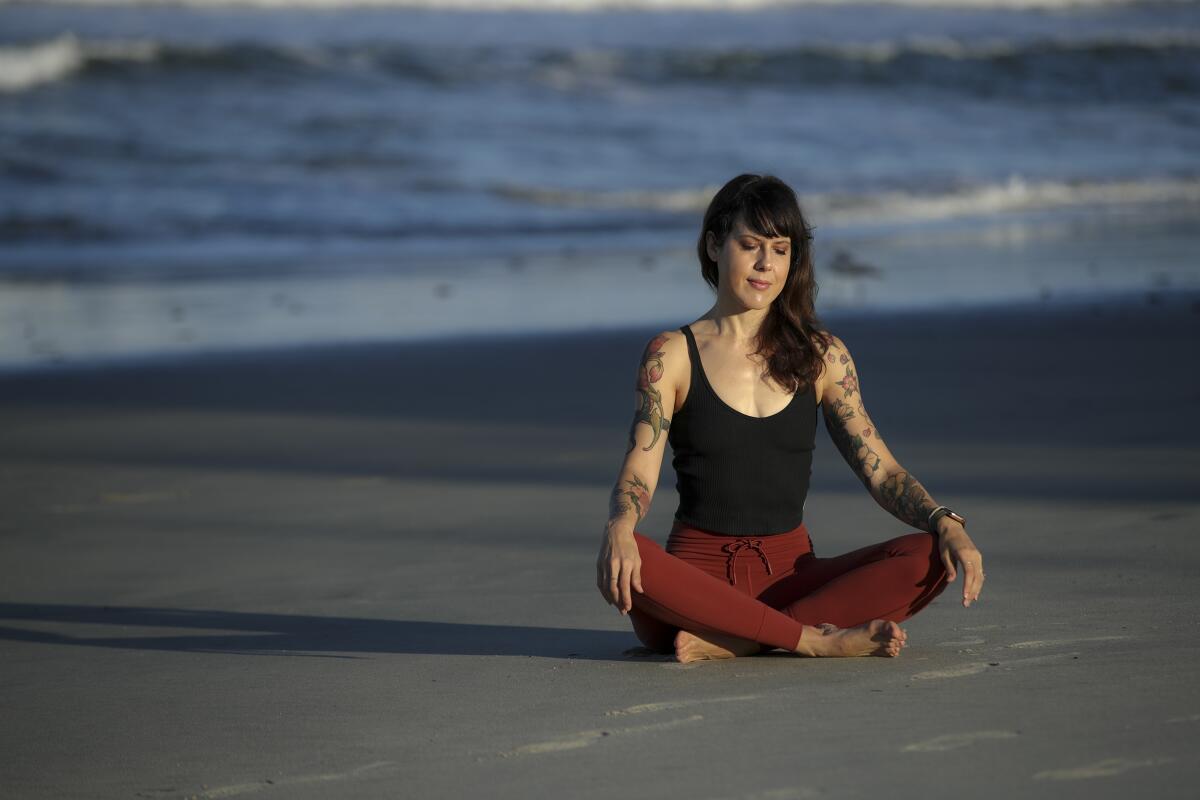
If you think QAnon is just a fringe movement, you haven’t been keeping up. It exploded in popularity while Donald Trump was in the White House and now has more adherents than some major religions.
Two recent polls found that about 1 in 6 Americans are onboard with QAnon’s key tenet: “that a cabal of Satan-worshiping pedophiles are trying to control the country’s government, mass media and financial systems,” as Nelson puts it.
QAnon‘s proponents were well-positioned to capitalize on the uncertainty brought on by the pandemic. When stay-at-home orders separated New Agers from their yoga studios and meditation rooms, they turned to Instagram, where aspiring influencers make controversial claims to get attention and build their brands.
It may seem like harmless nonsense, but consider this: The vast majority of people who are still dying of COVID-19 in the U.S. are those who haven’t been vaccinated.
More than 18,000 Americans died of COVID-19 in May, and only 150 of them were fully vaccinated. It stands to reason that if people took advantage of the vaccines, thousands of lives could be saved.
“This is a pandemic of unvaccinated people,” said L.A. County Public Health Director Barbara Ferrer, who is constantly urging people to get their shots.
A relatively small number of people have health conditions that make them ineligible for the vaccines, and some people who want them have been unable to get them due to financial, logistical or cultural barriers.
But that still leaves plenty of Americans with ready access to a doctor, a smartphone app or a Google search bar that would match them up with a vaccine. All they’re missing is the desire to do so.
California’s vaccination progress
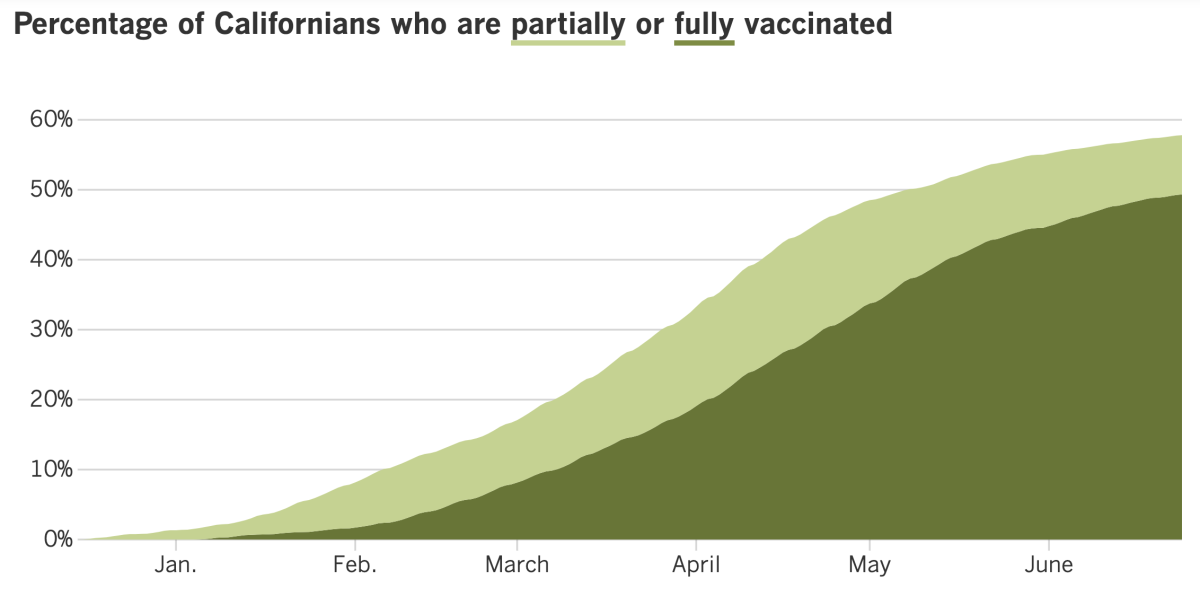
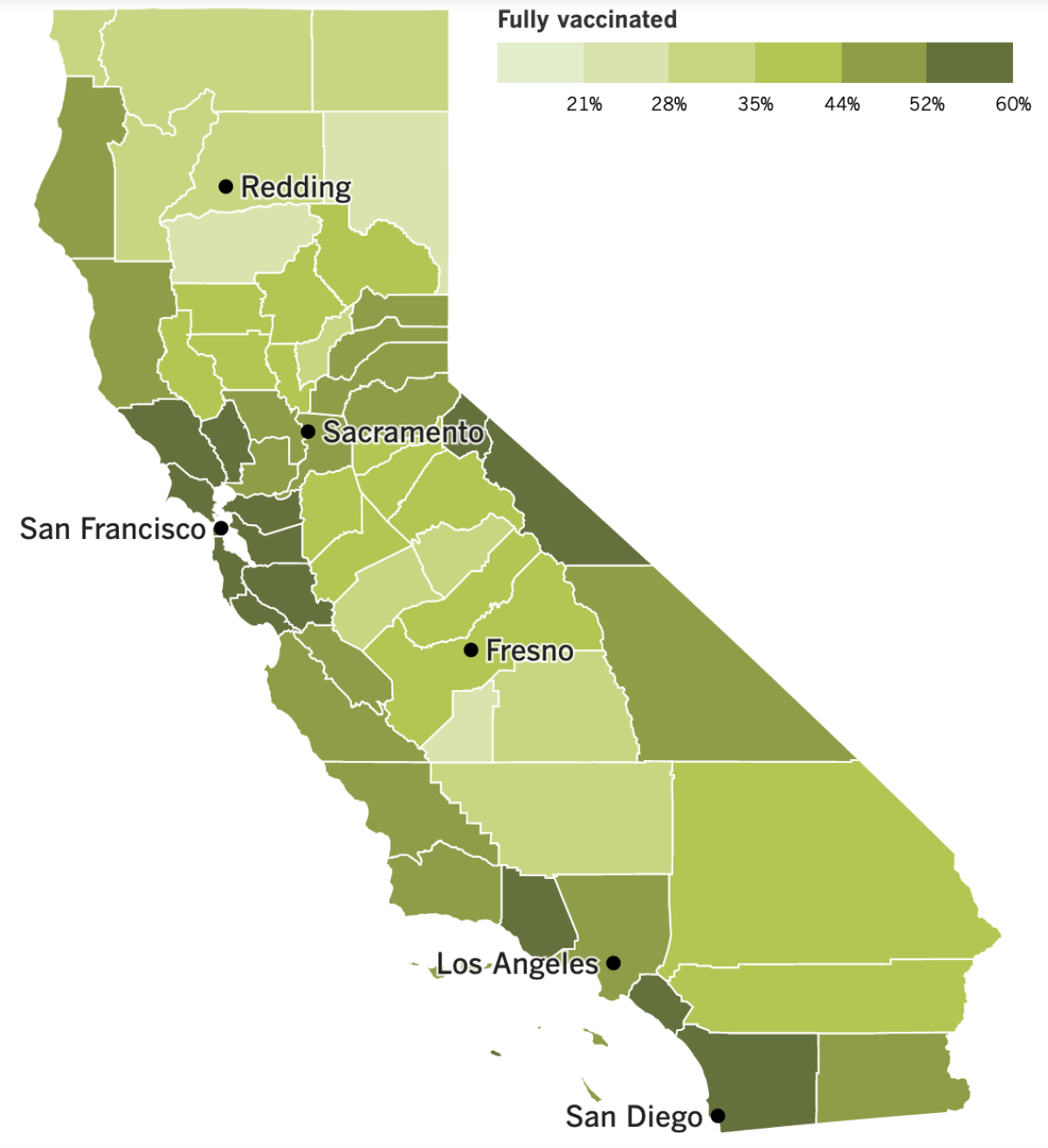
See the latest on California’s coronavirus closures and reopenings, and the metrics that inform them, with our tracker.
Consider subscribing to the Los Angeles Times
Your support helps us deliver the news that matters most. Become a subscriber.
In other news ...
When California reopened, officials warned that one of the things that could send the state back toward the lockdown days was the emergence of a coronavirus variant that was able to get around the defenses we’ve built up over the last year-plus. It looks like the Delta variant is auditioning for the role.
The Delta variant is the one that originated in India. It spreads more readily than its predecessors — perhaps twice as readily as the original strain — and there have been some indications that it’s less susceptible to the antibody treatments offered to COVID-19 patients.
So far, the vaccines available in the U.S. seem to be effective against Delta, but for those who remain unvaccinated, the risk of infection is real. “If you’re not vaccinated, you’re hosed,” said Dr. George Rutherford, an epidemiologist at UC San Francisco.
Delta currently ranks fourth among the variants identified when California coronavirus samples are genetically sequenced. (The top spot belongs to Alpha, the variant from the United Kingdom.) But it’s rising fast, growing from about 1.8% of sequenced samples in April to 4.8% in May.
Los Angeles County identified 64 cases involving the Delta variant between late April and early June, most of them in the last few weeks. Santa Clara County, the most populous county in Northern California, has turned up 58 cases.
With 58% of Californians at least partially vaccinated and 49% fully vaccinated, officials aren’t expecting Delta to produce another overwhelming surge. But they fear the variant will take root in communities where immunizations are low and people haven’t built up immunity through previous infections.
Speaking of previous infections, a new study by scientists at the National Institutes of Health finds that the official count of coronavirus cases before the country’s devastating fall-and-winter surge was way, way off.
For every infection recorded during the spring and summer of 2020, nearly five more went undetected. That amounts to nearly 17 million cases by July 2020 that were previously uncounted, my colleague Amina Khan reports.
The researchers determined this by gathering blood samples from thousands of people across the country and testing them for coronavirus antibodies — a sure sign of a previous infection. With all these cases accounted for, the NIH team offered a clearer picture of who had been swept up by the pandemic as of last summer.
For instance, 14.2% of Black Americans in the sample had been infected, along with 6.8% of Native Americans and Alaskan Natives and 6.1% of Latinos. At the other end of the spectrum, 2% of Asian American and 2.5% of white volunteers had been infected. The highest antibody prevalence was in adults ages 18 to 44 (5.9%), and people in urban areas (5.3%) were far more likely than those in rural areas (1.1%) to have evidence of a past infection.
And in other statistical news, a different group of researchers says the pandemic has slashed close to two years off Americans’ life expectancy. A baby born in the U.S in 2018 could expect to live 78.7 years; by the end of 2020, that number was down to 76.9.
The precipitous drop — more than eight times steeper than in any other country in the U.S.’ economic league — puts American life spans on par with those in Peru, Colombia, Chile and Thailand, my colleague Melissa Healy reports.
Even more shocking is the pandemic’s power to shorten the lives of Black and brown people in the U.S.
Thanks to COVID-19, the average life span of Black Americans shrank by more than three years between 2018 and 2020, to 71.5 years. At the same time, the average life span for white Americans fell less than half as much, to 77.3 years. That caused the gap between Black and white Americans to grow from 3.9 years to 5.8 years — wiping out two decades of progress in just one year.
The pandemic all but erased the longevity advantage of Latino Americans who, despite higher rates of poverty and hardship, historically lived close to three years longer than non-Hispanic whites. COVID-19’s toll on Latino communities — especially among working-age adults — reduced their average life expectancy from 81.8 years in 2018 to 78 years at the end of 2020.
“This was really disturbing,” said Dr. Stephen Woolf, a community health expert at Virginia Commonwealth University, who led the study. “It reflects the huge loss of life, and it demonstrates the price people pay for systemic racism.”
Meanwhile, in Houston, a hospital that says it’s the first in the nation to implement a COVID-19 vaccine mandate for employees has terminated at least 153 workers who refused to comply.
Houston Methodist Hospital allowed more than 600 exemptions for medical conditions (including deferments for women who were pregnant) and for those with a “sincerely held religious belief.” Still, out of more than 25,000 employees, two managers were fired for refusing the vaccine, and 178 other staffers were suspended for failing to meet the vaccination deadline. They were given until midnight Tuesday to get with the program; those that didn’t were fired or resigned.
The mass termination has reinvigorated the antivaccine movement and prompted a lawsuit challenging the mandate on the grounds that the vaccines — which have been authorized by the Food and Drug Administration for emergency use but have not received formal approval — are still experimental. But Dr. Marc Boom, Methodist’s chief executive, said he’s unfazed by the backlash.
“Criticism is sometimes the price we pay for leading medicine,” he said.
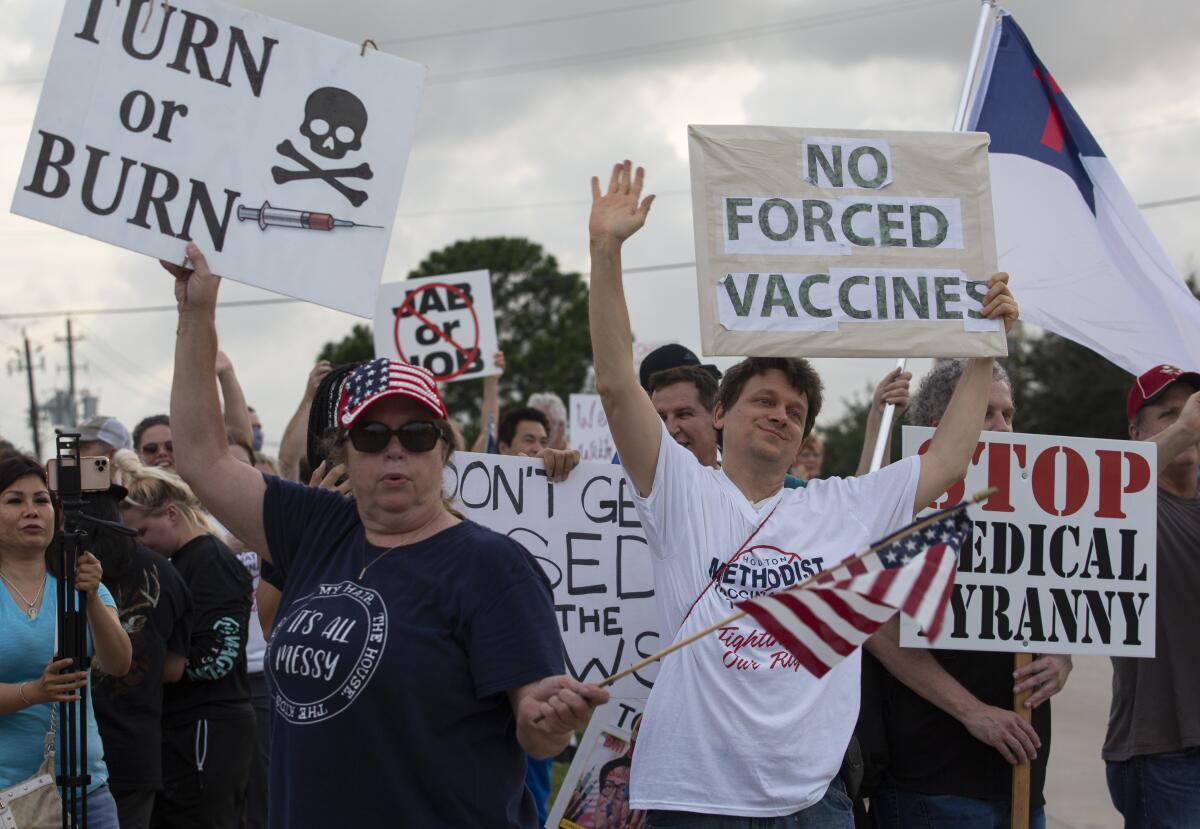
Your questions answered
Today’s question comes from readers who want to know: When will I need to get a COVID-19 booster shot?
It’s too soon to say. In fact, it’s too soon to say whether booster shots will be necessary at all.
There are two primary reasons why a booster shot would be in your future.
The first is that the immunity you gained from your initial COVID-19 vaccination has waned over the course of months or years.
Scientists are already seeing some evidence that the immunity provided by vaccines won’t last forever. (The same is true for immunity gained by an infection.) But even a seemingly dramatic decline in antibody levels may leave enough to protect us.
“The vaccines generated a vast excess of antibodies compared to what’s needed,” Dr. Otto Yang, an infectious disease specialist at ULCA, told my colleague Deborah Netburn. “Even 10% of the original antibody level is probably a lot.”
The second reason for a booster is that a new coronavirus variant comes along that’s able to evade the antibodies your body produced in response to the initial vaccine.
So far, the two-dose vaccines being administered in the United States have held up well against the coronavirus variants now in circulation, said Dr. Kawsar Talaat, associate professor of international health at the Johns Hopkins Bloomberg School of Public Health.
Only time will tell if that remains true, she said.
We want to hear from you. Email us your coronavirus questions, and we’ll do our best to answer them. Wondering if your question’s already been answered? Check out our archive here.
The pandemic in pictures
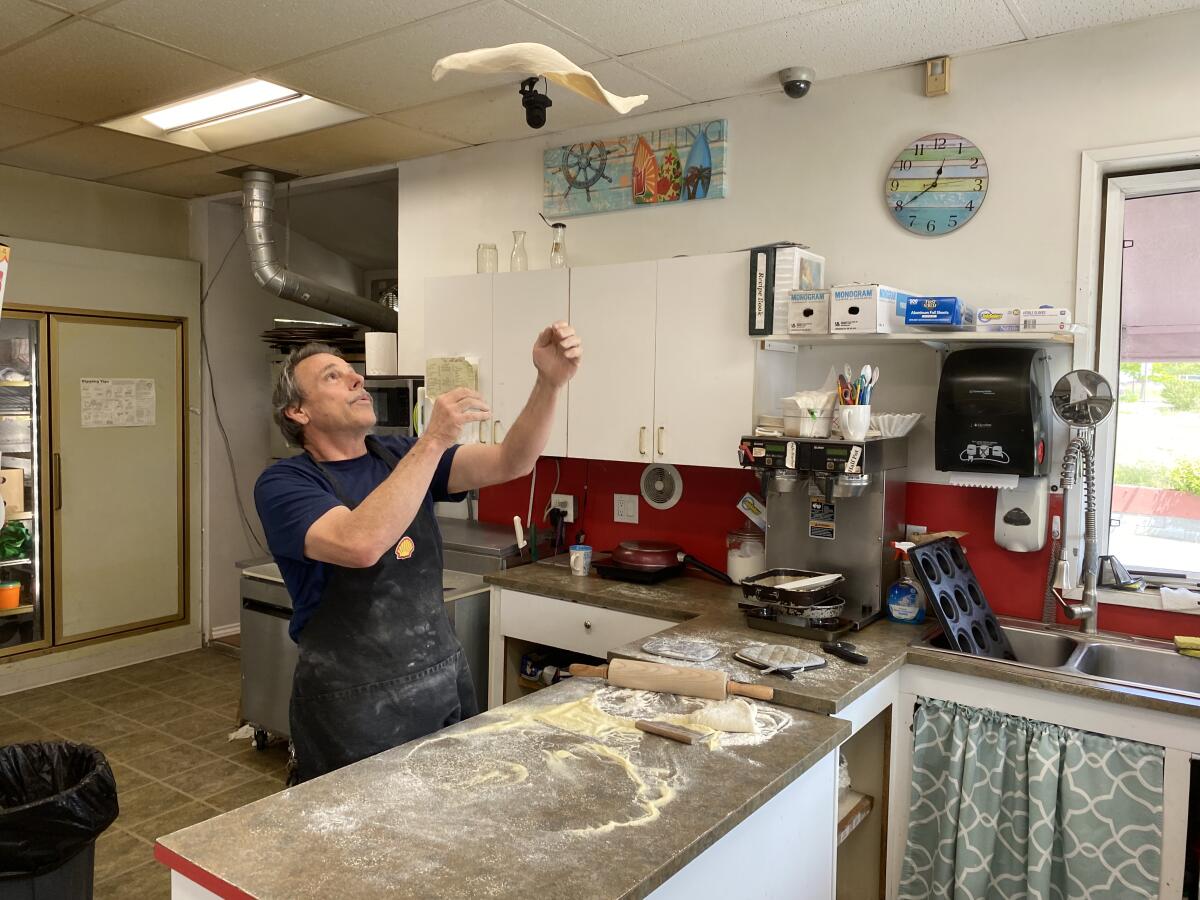
Chuck Laird, the man in the photo above, is tossing pizza dough in the air. What does that have to do with the pandemic?
If it weren’t for the coronavirus, Laird would be selling gasoline to customers of his Shell station in Point Roberts, Wash. But there’s not much demand for fuel in the 4.8-square-mile town, which is surrounded by water on three sides and borders Canada on the fourth.
U.S. and Canadian officials closed the international border on March 21, 2020. American residents of tiny Point Roberts were suddenly stranded — left without access to their doctors, schools and all kinds of services they once took for granted.
As the pandemic wore on, about 300 of Point Roberts’ residents decamped for the U.S. mainland, but 800 stayed behind, figuring the border was bound to reopen soon. So far, that hasn’t happened.
Don’t miss this tale by my colleague Richard Read about the Americans marooned on a virtual island.
Resources
Need a vaccine? Sign up for email updates, and make an appointment where you live: City of Los Angeles | Los Angeles County | Kern County | Orange County | Riverside County | San Bernardino County | San Diego County | San Luis Obispo County | Santa Barbara County | Ventura County
Need more vaccine help? Talk to your healthcare provider. Call the state’s COVID-19 hotline at (833) 422-4255. And consult our county-by-county guides to getting vaccinated.
Practice social distancing using these tips, and wear a mask or two.
Watch for symptoms such as fever, cough, shortness of breath, chills, shaking with chills, muscle pain, headache, sore throat and loss of taste or smell. Here’s what to look for and when.
Need to get tested? Here’s where you can in L.A. County and around California.
Americans are hurting in many ways. We have advice for helping kids cope, resources for people experiencing domestic abuse and a newsletter to help you make ends meet.
We’ve answered hundreds of readers’ questions. Explore them in our archive here.
For our most up-to-date coverage, visit our homepage and our Health section, get our breaking news alerts, and follow us on Twitter and Instagram.




